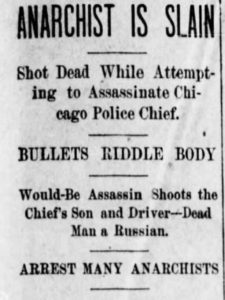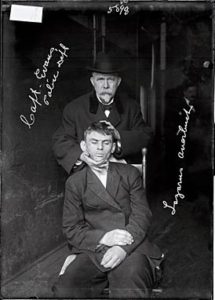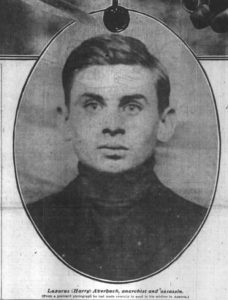
When thinking about the issue of police brutality in Chicago, many of our first thoughts find their way to the incidents of the recent past. The images that still burn freshly in our minds are those of Laquan McDonald being fatally shot from behind by Officer Jason Van Dyke, or a recently discovered history of gruesome torture by former police commander Jon Burge. While Chicago certainly has a history of police misconduct – Burge had reportedly been using torture to provide false confessions from his suspects since 1972 – that history sees its true beginnings in the early 20th century, as Jane Addams attempted to make sense of the violence she saw in her city of Chicago.

Addams’ first published opinion on file of a police brutality incident comes during the time of the “Averbuch Incident” in 1908. The chronicle, told in the papers from the point of view of Officer Shippy, begins with Lazarus Averbuch, as the press called him, though in realty his name may have been Harry or Jeremiah, a Russian born Jew who had recently immigrated to America. Averbuch was a young man, almost 19, who in the early morning of March 2, 1908 called upon Chicago’s Chief of Police, George Shippy, at his home in Chicago’s North Side. Shippy, having been informed that this was the fourth time Averbuch had called upon him in two days, became suspicious; assuming Averbuch was an anarchist bent on assassination, Shippy seized Averbuch by the arms. Before Shippy could disarm him, Averbuch drew a knife and stabbed Shippy in the arm. As Shippy’s son, Harry, ran downstairs due to the commotion, Averbuch drew a revolver and fired two shots, one of which struck Harry. At this, James Foley, an officer assigned to be George Shippy’s driver and bodyguard, entered and attempted to seize Averbuch. Before being embraced by Foley, however, Averbuch fired a shot into Foley’s hand. Very shortly after, both Foley and Shippy emptied their revolvers into Averbuch’s body, who then fell dead.
Funds were raised by prominent Jews for a private investigation into the claims made by Shippy that Averbuch was an anarchist intent on assassinating the Chicago Chief of Police. Jane Addams organized an investigation to be led by young Chicago attorney Harold Ickes, who later served as Secretary of the Interior under President Franklin Delano Roosevelt. At the same time, the Jewish press, mainly the Jewish Courier, tried to argue that Averbuch was following foreign protocol in order to obtain a letter from the chief of police indicating that he was in good standing and of good character in order to obtain a job outside his community. All shots, the Jewish press argued, were the result of wayward bullets fired from either Foley’s or Shippy’s guns. Addams witnessed the aftermath of the Averbuch Incident from an immediate proximity. Addams’ Hull-House was located near Averbuch’s community, and the settlement often served as an interpreter between foreigners and the city’s native populace, and vice versa. She understood that foreign-born anarchists were feared in the city of Chicago after their involvement in the Haymarket Riot two decades prior. Addams, however, was not convinced of Shippy’s story, believing there to be too many inconsistencies.

In the wake of the aftermath of the Averbuch Incident, Addams wrote a piece for Charities and the Commons, a publication created to help charities give and receive information and advice, called “The Chicago Settlements and Social Unrest”. This article, while spurred by the Averbuch Incident, also gave Addams’ opinion on the cause of and solutions to the growing unrest around immigrants with varying political and religious beliefs. Addams believed that she had a unique vantage point as the head of a settlement house – as a member of a prosperous family, Addams understood the points of view of the fearful public, as well as those of the fearful immigrant population. “This settlement interpretation,” she said, “may be right or wrong, but it is at least based upon years of first hand information and upon an opportunity for free intercourse with the foreign people themselves.” (Addams, 1908) She attempted to assuage the fears on Chicago, reminding the city that
“the more excited and irrational public opinion is, the more recklessly newspapers state mere surmises as facts, and upon these surmises arouse unsubstantiated prejudices against certain immigrants, the more necessary it is that some body of people be ready to put forward the spiritual and intellectual conditions of the foreign colony which is thus being made the subject of inaccurate surmises and unjust suspicion.” (Addams, 1908)
Addams reminded the public that Russian-Jews, like Averbuch, had escaped very harsh treatment from police while in their home country; she also argued that the treatment they received from American police was no better. “The older men,” she stated, “asked whether constitutional rights gave no guarantee against such violent aggression of police power, and the hot-headed ones cried out at once that the only way to deal with the police was to defy them; that that was true of the police the world over”. “It registered,” she said, “a conviction that in a moment of panic a republican government cared no more for justice and fair play than an autocratic government did” (Addams, 1908).
In true Addams fashion, the philanthropic philosopher gave her own homegrown solution to the problem at hand. “The only possible way to break down such a persistent and secretive purpose,” she said, “was by the kindliness which might have induced confession, which might have restored him into fellowship with normal men” (Addams, 1908).
Addams’ theory of kindness as an eradicator of terrorism has never really been tested in the city of Chicago, or anywhere else. One of the most recent stories about police brutality, mentioned above, states that former police commander, Lt. Jon Burge oversaw a torture ring of detectives from 1972 until 1991. In October of 2014, 17-year-old Laquan McDonald was shot fatally in the back 16 times by Jason Van Dyke – an officer who alone has accumulated 20 complaints, all of which have gone undisciplined. Citizens are so concerned about the escalation of crime in Chicago, that a website has been created to chronicle police misconduct spanning the years 2002-2008 and 2011-2015. The Citizens Police Data Project’s findings are astounding. Without revealing the entirety of the Project’s report, of all 56,384 of the allegations in the study, 54,089 of these, or 95.93%, were found to be “Unsustained”.
In another disheartening flurry of statistics, we also know that violence in Chicago is the highest among all US cities with 2,900 shootings in 2015. How much of a correlation do these two numbers have? And if the statistics are intertwined, is the answer to employ and release more officers into a populace that obviously entertains varying degrees of fear for their “protectors”? Or should we attempt to appeal to our better natures and try actions of kindness? Perhaps another of Addams’ solutions can be used, an effort to better educate officers, citizens, and members of immigrants and working class communities in lessons of cultural assimilation and understanding could be implemented to foster partnership based on harmony rather than discord.

Victoria Sciancalepore is the Assistant Editor at the Jane Addams Papers Project located at Ramapo College of New Jersey, funded by the NEH, NHPRC, and the Delmas Foundation. She is currently editing the Jane Addams Papers Digital Edition and The Selected Papers of Jane Addams Volumes 4 and 5 (forthcoming). She is also a project manager at the digital edition of The Penny Colman Collection of Historical Landmarks of Women. Victoria has been a member of the Association for Documentary Editing since 2016 for which she has given several presentations at its annual conferences and contributes to its newsletter. Previously, she was a transcription assistant at the Margaret Sanger Papers Project at New York University.


The Haymaeket incident (there was no riot) was the direct result of an aggressive police officer acting against the orders given to him directly by the Mayor.